
The Dred Scott Decision
By Bob Moore, JNEM Historian
![]() ne
of the most important cases ever tried in the United States was heard in
St. Louis' Old Courthouse. The two trials of Dred Scott in 1847 and 1850
were the beginning of a complicated series of events which concluded with
a U.S. Supreme Court decision in 1857, and hastened the start of the Civil
War.
ne
of the most important cases ever tried in the United States was heard in
St. Louis' Old Courthouse. The two trials of Dred Scott in 1847 and 1850
were the beginning of a complicated series of events which concluded with
a U.S. Supreme Court decision in 1857, and hastened the start of the Civil
War.

![]() When
the first case began in 1847, Dred Scott was about 50 years old. He was
born in Virginia about 1799, and was the property, as his parents had been,
of the Peter Blow family. He had spent his entire life as a slave, and
was illiterate. Dred Scott moved to St. Louis with the Blows in 1830, but
was soon sold due to his master's financial problems. He was purchased
by Dr. John Emerson, a military surgeon stationed at Jefferson Barracks,
and accompanied him to posts in Illinois and the Wisconsin Territory, where
slavery had been prohibited by the Missouri Compromise of 1820. During
this period, Dred Scott married Harriet Robinson, also a slave, at Fort
Snelling; they later had two children, Eliza and Lizzie. John Emerson married
Irene Sanford during a brief stay in Louisiana. In 1842, the Scotts returned
with Dr. and Mrs. Emerson in St. Louis. John Emerson died the following
year, and it is believed that Mrs. Emerson hired out Dred Scott, Harriet,
and their children to work for other families.
When
the first case began in 1847, Dred Scott was about 50 years old. He was
born in Virginia about 1799, and was the property, as his parents had been,
of the Peter Blow family. He had spent his entire life as a slave, and
was illiterate. Dred Scott moved to St. Louis with the Blows in 1830, but
was soon sold due to his master's financial problems. He was purchased
by Dr. John Emerson, a military surgeon stationed at Jefferson Barracks,
and accompanied him to posts in Illinois and the Wisconsin Territory, where
slavery had been prohibited by the Missouri Compromise of 1820. During
this period, Dred Scott married Harriet Robinson, also a slave, at Fort
Snelling; they later had two children, Eliza and Lizzie. John Emerson married
Irene Sanford during a brief stay in Louisiana. In 1842, the Scotts returned
with Dr. and Mrs. Emerson in St. Louis. John Emerson died the following
year, and it is believed that Mrs. Emerson hired out Dred Scott, Harriet,
and their children to work for other families.
![]() On April 6th, 1846,
Dred Scott and his wife Harriet filed suit against Irene Emerson for their
freedom. For almost nine years, Scott had lived in free territories, yet
made no attempt to end his servitude. It is not known for sure why he chose
this particular time for the suit, although historians have considered
three possibilities: He may have been dissatisfied with being hired out;
Mrs. Emerson might have been planning to sell him; or he may have offered
to buy his own freedom and been refused. It is known that the suit was
not brought for political reasons. It is thought that friends in St. Louis
who opposed slavery had encouraged Scott to sue for his freedom on the
grounds that he had once lived in a free territory. In the past, Missouri
courts supported the doctrine of "once free, always free." Dred Scott could
not read or write and had no money. He needed help with his suit. John
Anderson, the Scott's minister, may have been influential in their decision
to sue, and the Blow family, Dred's original owners, backed him financially.
The support of such friends helped the Scotts through nearly eleven years
of complex and often disappointing litigation.
On April 6th, 1846,
Dred Scott and his wife Harriet filed suit against Irene Emerson for their
freedom. For almost nine years, Scott had lived in free territories, yet
made no attempt to end his servitude. It is not known for sure why he chose
this particular time for the suit, although historians have considered
three possibilities: He may have been dissatisfied with being hired out;
Mrs. Emerson might have been planning to sell him; or he may have offered
to buy his own freedom and been refused. It is known that the suit was
not brought for political reasons. It is thought that friends in St. Louis
who opposed slavery had encouraged Scott to sue for his freedom on the
grounds that he had once lived in a free territory. In the past, Missouri
courts supported the doctrine of "once free, always free." Dred Scott could
not read or write and had no money. He needed help with his suit. John
Anderson, the Scott's minister, may have been influential in their decision
to sue, and the Blow family, Dred's original owners, backed him financially.
The support of such friends helped the Scotts through nearly eleven years
of complex and often disappointing litigation.
![]() It is difficult
to understand today, but under the law in 1846 whether or not the Scotts
were entitled to their freedom was not as important as the consideration
of property rights. If slaves were indeed valuable property, like a car
or an expensive home today, could they be taken away from their owners
because of where the owner had taken them? In other words, if you drove
your car from Missouri to Illinois, and the State of Illinois said that
it was illegal to own a car in Illinois, could the authorities take the
car away from you when you returned to Missouri? These were the questions
being discussed in the Dred Scott case, with one major difference: your
car is not human, and cannot sue you. Although few whites considered the
human factor in Dred Scott's slave suit, today we acknowledge that it is
wrong to hold people against their will and force them to work as people
did in the days of slavery.
It is difficult
to understand today, but under the law in 1846 whether or not the Scotts
were entitled to their freedom was not as important as the consideration
of property rights. If slaves were indeed valuable property, like a car
or an expensive home today, could they be taken away from their owners
because of where the owner had taken them? In other words, if you drove
your car from Missouri to Illinois, and the State of Illinois said that
it was illegal to own a car in Illinois, could the authorities take the
car away from you when you returned to Missouri? These were the questions
being discussed in the Dred Scott case, with one major difference: your
car is not human, and cannot sue you. Although few whites considered the
human factor in Dred Scott's slave suit, today we acknowledge that it is
wrong to hold people against their will and force them to work as people
did in the days of slavery.
![]()
 Hear
audio clips (RealAudio format) which feature a historical narrative from
Harriet Scott, who
talks about her struggle for freedom along with her husband, Dred.
Hear
audio clips (RealAudio format) which feature a historical narrative from
Harriet Scott, who
talks about her struggle for freedom along with her husband, Dred.
![]() RealAudio software to listen to the narratives can be downloaded
here.
RealAudio software to listen to the narratives can be downloaded
here.
![]() The Dred Scott
case was first brought to trial in 1847 in the first floor, west wing courtroom
of St. Louis' Courthouse. The Scotts lost the first trial because hearsay
evidence was presented, but they were granted the right by the judge to
a second trial. In the second trial, held in the same courtroom in 1850,
a jury heard the evidence and decided that Dred Scott and his family should
be free. Slaves were valuable property, and Mrs. Emerson did not want to
lose the Scotts,
The Dred Scott
case was first brought to trial in 1847 in the first floor, west wing courtroom
of St. Louis' Courthouse. The Scotts lost the first trial because hearsay
evidence was presented, but they were granted the right by the judge to
a second trial. In the second trial, held in the same courtroom in 1850,
a jury heard the evidence and decided that Dred Scott and his family should
be free. Slaves were valuable property, and Mrs. Emerson did not want to
lose the Scotts, 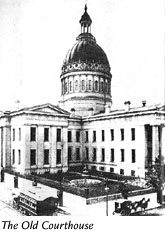 so
she appealed her case to the Missouri State Supreme Court, which in 1852
reversed the ruling made at the Old Courthouse, stating that "times now
are not as they were when the previous decisions on this subject were made."
The slavery issue was becoming more divisive nationwide, and provided the
court with political reasons to return Dred Scott to slavery. The court
was saying that Missouri law allowed slavery, and it would uphold the rights
of slave-owners in the state at all costs.
so
she appealed her case to the Missouri State Supreme Court, which in 1852
reversed the ruling made at the Old Courthouse, stating that "times now
are not as they were when the previous decisions on this subject were made."
The slavery issue was becoming more divisive nationwide, and provided the
court with political reasons to return Dred Scott to slavery. The court
was saying that Missouri law allowed slavery, and it would uphold the rights
of slave-owners in the state at all costs.
![]() Dred Scott was
not ready to give up in his fight for freedom for himself and his family,
however. With the help of a new team of lawyers who hated slavery, Dred
Scott filed suit in St. Louis Federal Court in 1854 against John F.A. Sanford,
Mrs. Emerson's brother and executor of the Emerson estate. Since Sanford
resided in New York, the case was taken to the Federal courts due to diversity
of residence. The suit was heard not in the Old Courthouse but in the Papin
Building, near the area where the north leg of the Gateway Arch stands
today. The case was decided in favor of Sanford, but Dred Scott appealed
to the U.S. Supreme Court.
Dred Scott was
not ready to give up in his fight for freedom for himself and his family,
however. With the help of a new team of lawyers who hated slavery, Dred
Scott filed suit in St. Louis Federal Court in 1854 against John F.A. Sanford,
Mrs. Emerson's brother and executor of the Emerson estate. Since Sanford
resided in New York, the case was taken to the Federal courts due to diversity
of residence. The suit was heard not in the Old Courthouse but in the Papin
Building, near the area where the north leg of the Gateway Arch stands
today. The case was decided in favor of Sanford, but Dred Scott appealed
to the U.S. Supreme Court.
![]() On March 6th, 1857,
Chief Justice Roger B. Taney delivered the majority opinion of the U.S.
Supreme Court in the Dred Scott case. Seven of the nine justices agreed
that Dred Scott should remain a slave, but Taney did not stop there. He
also ruled that as a slave, Dred Scott was not a citizen of the United
States, and therefore had no right to bring suit
On March 6th, 1857,
Chief Justice Roger B. Taney delivered the majority opinion of the U.S.
Supreme Court in the Dred Scott case. Seven of the nine justices agreed
that Dred Scott should remain a slave, but Taney did not stop there. He
also ruled that as a slave, Dred Scott was not a citizen of the United
States, and therefore had no right to bring suit 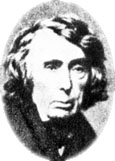 in
the federal courts on any matter. In addition, he declared that Scott had
never been free, due to the fact that slaves were personal property; thus
the Missouri Compromise of 1820 was unconstitutional, and the Federal Government
had no right to prohibit slavery in the new territories. The court appeared
to be sanctioning slavery under the terms of the Constitution itself, and
saying that slavery could not be outlawed or restricted within the United
States. The American public reacted very strongly to the Dred Scott Decision.
Antislavery groups feared that slavery would spread unchecked. The new
Republican Party, founded in 1854 to prohibit the spread of slavery, renewed
their fight to gain control of the Congress and the courts. Their well-planned
political campaign of 1860, coupled with divisive issues which split the
Democratic Party, led to the election of Abraham Lincoln as President of
the United States and South Carolina's secession from the Union. The Dred
Scott Decision moved the country to the brink of Civil War.
in
the federal courts on any matter. In addition, he declared that Scott had
never been free, due to the fact that slaves were personal property; thus
the Missouri Compromise of 1820 was unconstitutional, and the Federal Government
had no right to prohibit slavery in the new territories. The court appeared
to be sanctioning slavery under the terms of the Constitution itself, and
saying that slavery could not be outlawed or restricted within the United
States. The American public reacted very strongly to the Dred Scott Decision.
Antislavery groups feared that slavery would spread unchecked. The new
Republican Party, founded in 1854 to prohibit the spread of slavery, renewed
their fight to gain control of the Congress and the courts. Their well-planned
political campaign of 1860, coupled with divisive issues which split the
Democratic Party, led to the election of Abraham Lincoln as President of
the United States and South Carolina's secession from the Union. The Dred
Scott Decision moved the country to the brink of Civil War.
![]() Ironically, Irene
Emerson was remarried in 1850 to Calvin C. Chaffee, a northern congressman
opposed to slavery. After the Supreme Court decision, Mrs. Chaffee turned
Dred and Harriet Scott and their two daughters over to Dred's old friends,
the Blows, who gave the Scotts their freedom in May 1857. On September
17, 1858, Dred Scott died of tuberculosis and was buried in St. Louis.
His grave was moved in the 1860s to Calvary Cemetery in northern St. Louis,
and marked due to the efforts of the Rev. Edward Dowling in 1957. Dred
Scott did not live to see the fratricidal war touched off at Fort Sumter
in 1861, but did live to gain his freedom. The ultimate result of the war,
the end of slavery throughout the United States, was not something Dred
Scott could have foreseen in 1846, when he decided to sue for his freedom
in St. Louis' Old Courthouse.
Ironically, Irene
Emerson was remarried in 1850 to Calvin C. Chaffee, a northern congressman
opposed to slavery. After the Supreme Court decision, Mrs. Chaffee turned
Dred and Harriet Scott and their two daughters over to Dred's old friends,
the Blows, who gave the Scotts their freedom in May 1857. On September
17, 1858, Dred Scott died of tuberculosis and was buried in St. Louis.
His grave was moved in the 1860s to Calvary Cemetery in northern St. Louis,
and marked due to the efforts of the Rev. Edward Dowling in 1957. Dred
Scott did not live to see the fratricidal war touched off at Fort Sumter
in 1861, but did live to gain his freedom. The ultimate result of the war,
the end of slavery throughout the United States, was not something Dred
Scott could have foreseen in 1846, when he decided to sue for his freedom
in St. Louis' Old Courthouse.
![]()
Background: Slavery in Missouri
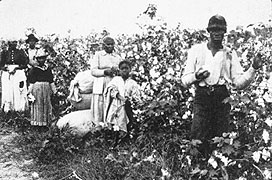
![]() Slavery
in Missouri was different from slavery in the deep south. The majority
of Missouri's slaves worked as field hands on farms along the fertile valleys
of the Mississippi and Missouri rivers. St. Louis, the largest city in
the state, maintained a fairly small African-American population throughout
the early part of the nineteenth century. Life in the cities was different
for African-Americans than life on a rural plantation. The opportunities
for interaction with whites and free blacks were constant, as were those
for greater freedom within their slave status. Because slavery was unprofitable
in cities such as St. Louis, African-Americans were often hired out to
others without a transfer of ownership. In fact, many masters illegally
allowed their slaves to hire themselves out and find their own lodgings.
This unusual state of affairs taught African-Americans to fend for themselves,
to market their abilities wisely, and to be thrifty with their money.
Slavery
in Missouri was different from slavery in the deep south. The majority
of Missouri's slaves worked as field hands on farms along the fertile valleys
of the Mississippi and Missouri rivers. St. Louis, the largest city in
the state, maintained a fairly small African-American population throughout
the early part of the nineteenth century. Life in the cities was different
for African-Americans than life on a rural plantation. The opportunities
for interaction with whites and free blacks were constant, as were those
for greater freedom within their slave status. Because slavery was unprofitable
in cities such as St. Louis, African-Americans were often hired out to
others without a transfer of ownership. In fact, many masters illegally
allowed their slaves to hire themselves out and find their own lodgings.
This unusual state of affairs taught African-Americans to fend for themselves,
to market their abilities wisely, and to be thrifty with their money.
![]() Slavery was not
a "Southern" problem alone. Many northern states phased out slavery as
late as the 1830s, and states such as Delaware and New Jersey still had
slave-owning residents as late as 1860. On a local level, residents of
Illinois owned slaves (under long-term indenture agreements of 40 years
or longer) during the period of the Dred Scott trials, and a special provision
in the Illinois constitution allowed slaves to work in the salt mines across
the Mississippi from St. Louis as long as they were not held there for
over one year at a stretch. Many people in southern Illinois supported
slavery. No slaves in the St. Louis area picked cotton however, and few
worked in farm fields. Most worked as stevedores and draymen on the riverfront,
on riverboats, in the lead and salt mines, as handymen, janitors and porters
(like Dred Scott), and as maids, nannies, and laundresses (like Harriet
Scott).
Slavery was not
a "Southern" problem alone. Many northern states phased out slavery as
late as the 1830s, and states such as Delaware and New Jersey still had
slave-owning residents as late as 1860. On a local level, residents of
Illinois owned slaves (under long-term indenture agreements of 40 years
or longer) during the period of the Dred Scott trials, and a special provision
in the Illinois constitution allowed slaves to work in the salt mines across
the Mississippi from St. Louis as long as they were not held there for
over one year at a stretch. Many people in southern Illinois supported
slavery. No slaves in the St. Louis area picked cotton however, and few
worked in farm fields. Most worked as stevedores and draymen on the riverfront,
on riverboats, in the lead and salt mines, as handymen, janitors and porters
(like Dred Scott), and as maids, nannies, and laundresses (like Harriet
Scott).
![]()
Additional Information
![]() In addition to
slaves, St. Louis also had a fairly large free black community. African-Americans
in St. Louis were able to live within the strict "black codes", which were
harsh laws that applied to all African-Americans, both free and slave.
Many free blacks owned businesses which carted goods from place to place
after they
In addition to
slaves, St. Louis also had a fairly large free black community. African-Americans
in St. Louis were able to live within the strict "black codes", which were
harsh laws that applied to all African-Americans, both free and slave.
Many free blacks owned businesses which carted goods from place to place
after they 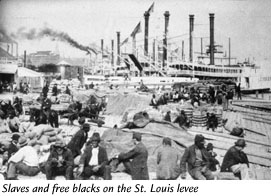 were off-loaded from river boats. Real estate was also a
business known to free blacks. Others owned large barber emporiums, some
with real gold faucets, marble countertops and crystal chandeliers, which
were used by all the important white men of the town. These barbers were
able to gather information that their white customers discussed and pass
it along to the black community. Many became so rich that they became known
as the "Colored Aristocracy" of St. Louis.
were off-loaded from river boats. Real estate was also a
business known to free blacks. Others owned large barber emporiums, some
with real gold faucets, marble countertops and crystal chandeliers, which
were used by all the important white men of the town. These barbers were
able to gather information that their white customers discussed and pass
it along to the black community. Many became so rich that they became known
as the "Colored Aristocracy" of St. Louis.
![]() By 1835 an African-American
church had started in St. Louis; Sundays were also days of rest for the
slaves, when gossip and news could be passed from one African-American
to another, in or out of church. African-Americans who were literate would
read newspapers aloud to others at night or on Sunday. These circumstances
made urban slavery unusual. An African-American could acquire accurate
information about nearly any subject, including how to sue for one's freedom.
By 1835 an African-American
church had started in St. Louis; Sundays were also days of rest for the
slaves, when gossip and news could be passed from one African-American
to another, in or out of church. African-Americans who were literate would
read newspapers aloud to others at night or on Sunday. These circumstances
made urban slavery unusual. An African-American could acquire accurate
information about nearly any subject, including how to sue for one's freedom.
![]() Because slavery
in St. Louis became less and less profitable as years went by, masters
hired out their slaves, usually for periods of a year at a time. This meant
that slaves encountered a certain amount of uncertainty regarding whom
they would be working for from year to year. Often, slaves, were able to
save a cut of their wages for themselves. This meant that after years of
saving, they might be able to purchase their own freedom. Several St. Louis
slaves did just that, although it was expensive; an average healthy male
slave sold for about $500 in 1850, roughly $14,000 in today's money. In
several cases, a father would purchase his freedom, set up a business,
and save enough money to purchase his wife and children from their masters;
he could then set them free legally.
Because slavery
in St. Louis became less and less profitable as years went by, masters
hired out their slaves, usually for periods of a year at a time. This meant
that slaves encountered a certain amount of uncertainty regarding whom
they would be working for from year to year. Often, slaves, were able to
save a cut of their wages for themselves. This meant that after years of
saving, they might be able to purchase their own freedom. Several St. Louis
slaves did just that, although it was expensive; an average healthy male
slave sold for about $500 in 1850, roughly $14,000 in today's money. In
several cases, a father would purchase his freedom, set up a business,
and save enough money to purchase his wife and children from their masters;
he could then set them free legally.
![]() Missouri slave-holders
were worried about the rise in the population of free blacks. Many whites
provoked incidents meant to strike fear into the hearts of free blacks,
or to get them to leave Missouri. It was generally believed by slave-holders
that free blacks stirred up discontent among the slaves, and caused them
to run away, slow down their work, or sue for their freedom if they were
eligible.
Missouri slave-holders
were worried about the rise in the population of free blacks. Many whites
provoked incidents meant to strike fear into the hearts of free blacks,
or to get them to leave Missouri. It was generally believed by slave-holders
that free blacks stirred up discontent among the slaves, and caused them
to run away, slow down their work, or sue for their freedom if they were
eligible.
![]()
The Dred Scott Courtroom in St. Louis' Old Courthouse
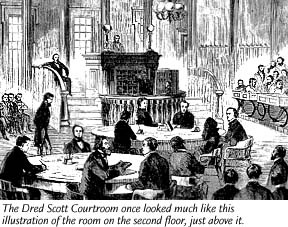
![]() The
courtroom where the Dred Scott cases were heard is no longer in existence.
In 1855, even before the Scotts' campaign for their freedom ended,
the courtroom received extensive renovation. The large courtroom, as originally
constructed, occupied the entire west wing. An architectural flaw was discovered
which threatened the wing's ceiling on the first floor, and additional
support was required. As a result, a new corridor running on an east-west
axis was added, dividing the large courtroom where the Scott trials were
heard into two smaller courtrooms. A display about the trial is exhibited
in this corridor, near the original site.
The
courtroom where the Dred Scott cases were heard is no longer in existence.
In 1855, even before the Scotts' campaign for their freedom ended,
the courtroom received extensive renovation. The large courtroom, as originally
constructed, occupied the entire west wing. An architectural flaw was discovered
which threatened the wing's ceiling on the first floor, and additional
support was required. As a result, a new corridor running on an east-west
axis was added, dividing the large courtroom where the Scott trials were
heard into two smaller courtrooms. A display about the trial is exhibited
in this corridor, near the original site.
![]()
Park Info | Arch
History & Architecture | Museum
Tour | Top of the Arch
| Old Courthouse
St. Louis History
| Films | Educator's
Guide | Library/Archives
| Volunteer! | Credits
What's New | Lewis & Clark | Special Events | Permanent Exhibits | National Park Service | St. Louis Info. | News Releases | Traveling Exhibits
![]()